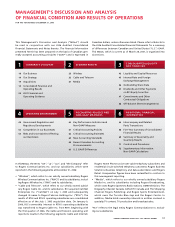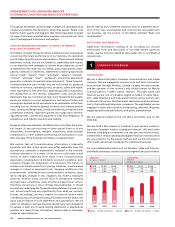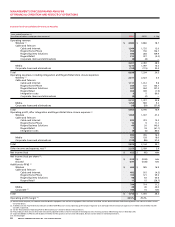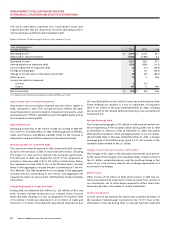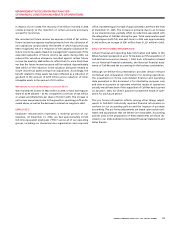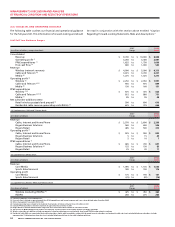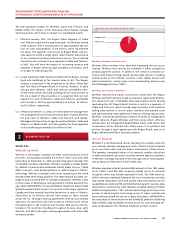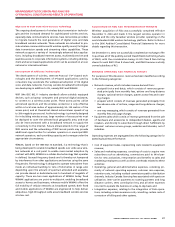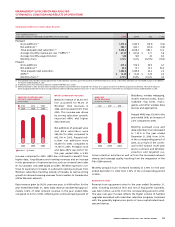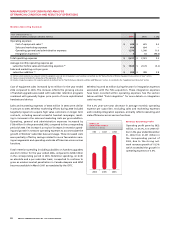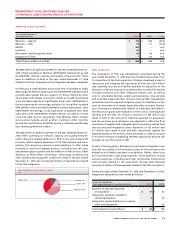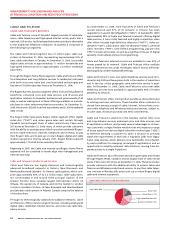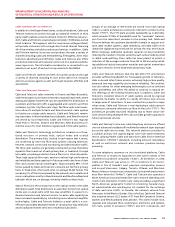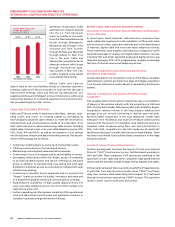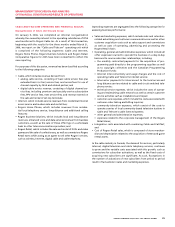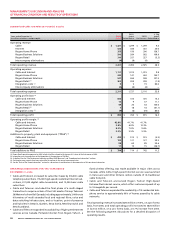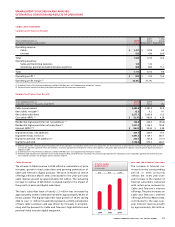Rogers 2006 Annual Report Download - page 31
Download and view the complete annual report
Please find page 31 of the 2006 Rogers annual report below. You can navigate through the pages in the report by either clicking on the pages listed below, or by using the keyword search tool below to find specific information within the annual report.
27
RO GER S CO MMU NIC AT ION S IN C . 20 0 6 ANN UA L RE POR T
MANAGEMENT’S DISCUSSION AND ANALYSIS
OF FINANCIAL CONDITION AND RESULTS OF OPERATIONS
Migration to Nex t Generation Wireless Technology
The ongoing development of wireless data transmission technolo-
gies and the increased demand for sophisticated wireless services,
especially data communications services, have led wireless providers
to migrate towards the next generation of digital voice and data
broadband wireless networks. These networks are intended to pro-
vide wireless communications with wireline quality sound, far higher
data transmission speeds and streaming video capabilities. These
networks support a variety of increasingly advanced data applica-
tions, including broadband Internet access, multimedia services and
seamless access to corporate information systems, including desktop,
client and server-based applications which can be accessed on a local,
national or international basis.
Development of Additional Technologies
The development of wireless, Internet Protocol (“IP”)-based tech-
nologies and the development of IP-based applications used by
consumers may accelerate the widespread adoption of 3G digital
voice and data networks. Two key wireless broadband technologies
are developing in addition to 3G, namely WiFi and WiMAX.
WiFi (the IEEE 802.11 industry standard) allows suitably equipped
devices, such as laptop computers and personal digital assistants,
to connect to a wireless access point. These access points utilize
unlicenced spectrum and the wireless connection is only effective
within a local area radius of approximately 50–100 metres of the
access point, and at theoretical shared network/user speeds of up
to 200 megabits per second. As the technology is primarily designed
for in-building wireless access, large numbers of access points must
be deployed to cover the selected local geographic area, and must
also be interconnected with a broadband network to supply the
connectivity to the Internet. Future enhancements to the range of
WiFi service and the networking of WiFi access points may provide
additional opportunities for wireless operators or municipal WiFi
network operators, each providing capacity and coverage under the
appropriate circumstances.
WiMAX, based on the IEEE 802.16 standard, is a technology that is
being developed to enable broadband speeds over wide area wire-
less networks at a cost point to enable mass market adoption. By
contrast with WiFi, WiMAX is a cellular-like technology that operates
in defined, licenced frequency bands and is thereby not hampered
by interference from other applications and services using the same
frequencies. The technology is designed to operate everywhere from
inside an individual building to tens of kilometres in range and,
depending upon the amount of spectrum allocated and available,
can provide shared or dedicated access to hundreds of megabits of
capacity. There are two main applications of WiMAX today: fixed
WiMAX applications are point-to-multipoint enabling broadband
access to homes and businesses, whereas mobile WiMAX offers the
full mobility of cellular networks at broadband speeds. Both fixed
and mobile applications of WiMAX are engineered to help deliver
ubiquitous, high-throughput wide area broadband wireless services
at a low cost.
ACQUISITION OF FIDO AND PRIVATIZATION OF WIRELESS
Wireless’ acquisition of Fido was successfully completed effective
November 9, 2004 and made it the largest wireless operator in
Canada and the only Canadian wireless provider operating on the
world standard GSM wireless technology platform. Refer to Note 4
to the 2006 Audited Consolidated Financial Statements for more
details regarding this transaction.
On December 31, 2004, we successfully completed an exchange offer
to purchase all of the publicly-owned Class B Restricted Voting shares
of RWCI, with the consideration being 3.5 RCI Class B Non-Voting
shares for each RWCI Class B share held, and RWCI became a wholly
owned subsidiary of RCI.
WIRELESS OPERATING AND FINANCIAL RESULTS
For purposes of this discussion, revenue has been classified according
to the following categories:
• Network revenue, which includes revenue derived from:
• postpaid (voice and data), which consists of revenues gener-
ated principally from monthly fees, airtime and long-distance
charges, optional service charges, system access fees and roam-
ing charges;
• prepaid, which consists of revenues generated principally from
the advance sale of airtime, usage and long-distance charges;
and
• one-way messaging, which consists of revenues generated from
monthly fees and usage charges.
• Equipment sales which consist of revenue generated from the sale
of hardware and accessories to independent dealers, agents and
retailers, and directly to subscribers through direct fulfillment by
Wireless’ customer service groups, websites and telesales, net of
subsidies.
Operating expenses are segregated into the following categories for
assessing business performance:
• Cost of equipment sales, representing costs related to equipment
revenue;
• Sales and marketing expenses, consisting of costs to acquire new
subscribers such as advertising, commissions paid to third par-
ties for new activations, remuneration and benefits to sales and
marketing employees as well as direct overheads related to these
activities;
• Operating, general and administrative expenses, consisting pri-
marily of network operating expenses, customer care expenses,
retention costs, including residual commissions paid to distribution
channels, Industry Canada licencing fees associated with spectrum
utilization, inter-carrier payments to roaming partners and long
distance carriers, CRTC contribution levy and all other expenses
incurred to operate the business on a day-to-day basis; and
• Integration expenses, relating to the integration of Fido opera-
tions, including certain severance costs, consulting, certain costs of
conversion of billing and other systems.


